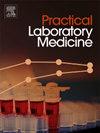Impact of hemolysis on the levels of proteins associated with aging and age-related neurodegenerative diseases in a multicentric clinical research
IF 1.7
Q3 MEDICAL LABORATORY TECHNOLOGY
引用次数: 0
Abstract
Introduction
Hemolysis is a known interference factor that has been found to show erroneous effect. Present study analyzes the impact of hemolysis on the concentrations of protein biomarkers of Alzheimer's disease (Aβ42, t-Tau, p-Tau181) along with novel proteins which are currently under investigation (SIRT1,SIRT2,SIRT6,FOXO3A, NFL, Aβ40, GFAP).
Methods
Plasma samples were grouped into two categories: hemolyzed and non-hemolyzed groups. Degree of hemolysis (in percentage) was separately analyzed using Single molecule array (SIMOA) technology. Quantitative analysis for hemolyzed and non-hemolyzed samples were done using surface plasmon resonance (SPR) technology.
Results
The SIMOA analysis indicated that at high levels of hemolysis (1000 mg/dL) there was an increase in NFL protein level up to approximately 30 % whereas p-Tau181 did not show much interference even at higher hemolysate concentration. Aβ40, Aβ42 and GFAP showed modest effect up to hemolysis of 250mg/dL-500 mg/dL. SPR analysis of total Tau (t-Tau), p-Tau181, SIRT1, SIRT6 showed the consistency in the result and there was no significant difference in hemolyzed plasma compared to non-hemolyzed samples. Aβ42 and FOXO3A showed decline in hemolyzed plasma compared to non-hemolyzed samples (4.34 ± 0.18ng/ul; 4.95 ± 0.19ng/ul) and (3.83 ± 0.34ng/ul; 5.12 ± 0.46ng/ul), respectively whereas, a significant increase in the concentration was observed for SIRT2; 2.4 ± 0.10ng/ul in hemolyzed compared to 1.30 ± 0.22ng/ul in non-hemolyzed group.
Conclusions
High grade hemolysis leads to altered protein concentration associated with neurodegeneration. Present study emphasizes the need to have pre-analytical inspection for hemolysis detection especially in a multicentric biomarker study.
求助全文
约1分钟内获得全文
求助全文
来源期刊

Practical Laboratory Medicine
Health Professions-Radiological and Ultrasound Technology
CiteScore
3.50
自引率
0.00%
发文量
40
审稿时长
7 weeks
期刊介绍:
Practical Laboratory Medicine is a high-quality, peer-reviewed, international open-access journal publishing original research, new methods and critical evaluations, case reports and short papers in the fields of clinical chemistry and laboratory medicine. The objective of the journal is to provide practical information of immediate relevance to workers in clinical laboratories. The primary scope of the journal covers clinical chemistry, hematology, molecular biology and genetics relevant to laboratory medicine, microbiology, immunology, therapeutic drug monitoring and toxicology, laboratory management and informatics. We welcome papers which describe critical evaluations of biomarkers and their role in the diagnosis and treatment of clinically significant disease, validation of commercial and in-house IVD methods, method comparisons, interference reports, the development of new reagents and reference materials, reference range studies and regulatory compliance reports. Manuscripts describing the development of new methods applicable to laboratory medicine (including point-of-care testing) are particularly encouraged, even if preliminary or small scale.
 求助内容:
求助内容: 应助结果提醒方式:
应助结果提醒方式:


